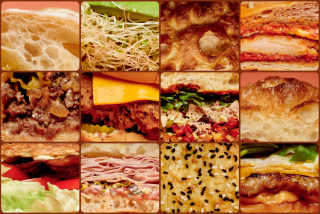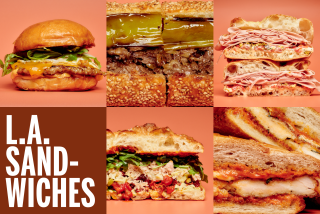The Seamless Sandwich
- Share via
The first time I made a pocket sandwich, I thought I’d really invented something. I had some extra bread dough and some leftovers from dinner, so I formed the dough into pockets, filled them with the leftovers and put them in the oven to bake. I ended up with the perfect brown-bag sandwich.
Now packing school lunches takes little more than opening the freezer. (I bake the pockets ahead, a dozen at a time.) By lunchtime the sandwiches are thawed and ready to eat, warm if the bag’s been put in the sunshine, hot if the sandwich is wrapped in foil and put on the radiator about 1/2 hour before the lunch bell.
Of course, the Italians were making calzone long before I ever thought of baking pockets. And I quickly found that supermarkets are full of variations of my pocket invention. But these grocery-store pockets cost a lot, are greasy and are full of dubious additives. None of them taste nearly as good as homemade.
The semi-caramelized onions that line the pockets act as a flavorful moisturizer in place of butter, mayonnaise, or another fat, which would get lost in baking.
POCKET SANDWICHES
1 tablespoon dry yeast
1/2 cup room-temperature water
2 cups milk
1/2 cup wheat germ
1/4 cup sesame seeds
2 cups whole-wheat bread flour
6 cups chopped onions
1 1/2 tablespoons olive oil
3 tablespoons bacon fat, chicken fat or olive oil
2 teaspoons salt, or 1 1/2 teaspoons if using bacon fat
4 1/2 cups unbleached bread flour
Cornmeal
Fillings
Dissolve yeast in water in large warmed bowl. Beat in milk, then wheat germ, sesame seeds and whole-wheat flour to make thick batter. Cover with damp towel and set in warm place until light and bubbly, 1 to 1 1/2 hours.
While sponge rises, combine onions and 1 1/2 tablespoons olive oil in wide, preferably non-stick skillet and place over medium heat. Cook, stirring frequently, until onions are translucent, then lower heat and continue cooking until onions are even, deep gold-brown.
When sponge has risen, stir down sponge, add fat and salt, and let stand about 5 minutes. Add bread flour, first stirring, then kneading, to get firm, slightly sticky dough. Cover and let rise until almost double, 45 minutes to 1 hour.
Set out Fillings and small bowl water. Sprinkle 2 flat baking sheets with cornmeal and set aside.
Punch down risen dough, knead briefly and divide into 12 portions. Roll each into ball, and let stand 5 minutes. Flour work surface and roll 1 ball into disk about 1/8-inch thick. Repeat process until no room remains for rolling out and reserve remaining balls.
Use water to moisten band around edge of each disk. Spread about 1/4 cup onion mixture in center and top with Filling. Fold pocket into 1/2 moon, press to equalize filling, then press edges to seal well. Starting at 1 corner, fold over about 1/2 inch dough, then proceed right around edge, pleating at roughly 1/2-inch intervals to get raised rim. Tuck under tail of dough that should remain at end.
Place filled pockets on prepared baking sheets, allowing plenty of space around each. Bake at 425 degrees 15 to 20 minutes, or until risen and lightly browned. Pockets should be darker than whole-wheat pita, but lighter than loaf bread.
Cool pockets on wire racks, then wrap tightly in foil or plastic wrap and freeze. Makes 12 large sandwiches.
Fillings
Filling choices are endless; just remember that because the bread is substantial, they need to be strongly flavored: spicy, smoky or heavily herbed. The onions are almost as moist as mayonnaise, but they can’t compensate for water-packed tuna or similarly sawdust-y items.
The mayonnaise in chicken salad will be absorbed by the bread, and so will almost all peanut butter and jelly; so those old standbys are out. But almost anything else goes: ham, ham and cheese, any kind of sausage, cooked beef (hamburger tends to get dried out so go heavy on the onions if you use it). Curried chickpeas--1 teaspoon curry and 1 tablespoon butter per cup of cooked chickpeas--make a nice vegetarian option; so does grilled eggplant with sauteed peppers and plenty of garlic.
Quantities are a matter of taste. I know two people who are appalled at the amount of ham in my sandwiches: one who thinks I’m a spendthrift headed for early cardiac arrest, another who regards me as a miser. In general, the total volume of filling (don’t forget those onions) should be about the same as it would be for a conventional sandwich of the same dimensions. The only limit is the bread--it won’t stretch over Dagwood-style piles of goodies.
Remember when lining things up that you’re making a dozen sandwiches, which takes quite a bit of filling even if you’re on the conservative side. It’s easier and more economical to use an assortment of fillings--leftover roast chicken, shredded cheese ends, the last sausage from a mixed grill. Since the pockets all look pretty much alike once made, I bake in a wood pick identification system. For example, a whole wood pick means ham, a half wood pick means chicken, a half wood pick with its end wrapped in foil signals cheese. With curried chickpeas you don’t have to worry; they’re the ones with the curry stains on the outside of the bread.
More to Read
Eat your way across L.A.
Get our weekly Tasting Notes newsletter for reviews, news and more.
You may occasionally receive promotional content from the Los Angeles Times.










